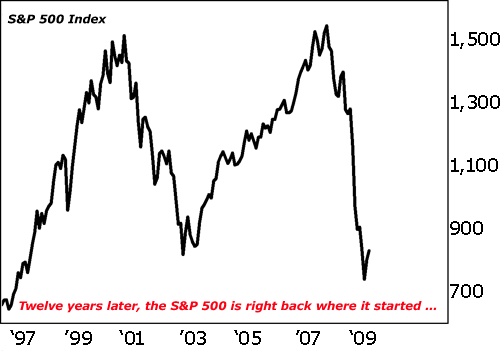Deflation Continues, Will the United States Become Another Japan?
Economics / Deflation Apr 22, 2009 - 06:54 AM GMT Nilus Mattive writes: Clearly, deflation remains the biggest near-term threat to the U.S. economy.At the consumer level, prices pulled back 0.1 percent during the month of March. That was mainly driven by declining energy prices, and in spite of the biggest jump in tobacco prices in at least 10 years. (The government initiated a large tax hike on smokes during April.)
Nilus Mattive writes: Clearly, deflation remains the biggest near-term threat to the U.S. economy.At the consumer level, prices pulled back 0.1 percent during the month of March. That was mainly driven by declining energy prices, and in spite of the biggest jump in tobacco prices in at least 10 years. (The government initiated a large tax hike on smokes during April.)
For the 12-month period ending in March, prices for consumer goods dropped 0.4 percent. That’s the first 12-month bout of deflation in 44 years!
And the March data on producer prices showed a 1.2 percent drop, too.
These are shocking reminders that despite the government’s best efforts, and despite the stock market’s substantial rally, the U.S. is still struggling with a rather dangerous deflationary trend.
And perhaps that’s why …
Many Continue Asking: Will We “Become Like Japan?”
During a recent interview, that question came up yet again.
The fear is that people become so shell-shocked that our country will suffer a protracted bout of deflation and a stuck-in-the-mud economy.
To be sure, there are parallels between our current situation and what happened in Japan back in the 1990s.
We’ve had a real estate bust. Interest rates are practically at zero. Stocks have cratered. The list of similarities goes on and on!
Yet I do not see the same end result here in the United States.
We are far bigger, and more diversified. Plus, I still feel very strong pockets of unbridled optimism in this country.
Even now, there are plenty of people finding novel new ways to get rich!
For example, a few months ago I read a story about a guy in Las Vegas who started a business that profits from the foreclosure crisis.
No, he doesn’t buy distressed property. He goes around spray-painting lawns green!
Sounds crazy, right? Well, banks and other real estate sellers are using this guy’s service as a cheap way to make their listings look more presentable to prospective buyers. And he’s making a whole lot of green in the process.
 |
| Making money by spray-painting foreclosed homes’ lawns? Now that’s American ingenuity! |
I couldn’t think of a better symbol of our country’s resiliency and resourcefulness!
I suppose I’m in the minority, but I continue to believe that our nation is still made up of creative, entrepreneurial people who are going to continue innovating, borrowing, and plugging along!
The United States remains the economic engine of the world. No country is better at dreaming, designing, and implementing. I am reminded of that every time I see a product package that says “Designed in the U.S.; Manufactured in China.”
What About Consumers? Haven’t They Been Scared Away from Spending?
To some degree, yes.
The March retail sales numbers showed a decline of 1.1 percent. And even if you exclude auto sales, results were still off by 0.9 percent. But even now I also see plenty of people still out spending.
For example, I took my family down to the beach this past weekend and I couldn’t get over how many people were swarming the shops and restaurants.
And when I looked at seasonal rental sheets, the vast majority of units were rented straight through the season!
I do think the idea of more modest spending — and more vigorous saving — is being revisited in this country. That’s a good thing.
At the same time, I do not see a complete cultural shift taking place. And since deflationary spirals are largely driven by psychology, I don’t see one taking place here.
Of course, I recognize that there’s another implied question when someone asks me about a Japan-style situation …
Will We See a “Lost Decade” in Stocks As the Economy Muddles Along?
My answer: We’ve already seen one!
Even now, after a very nice rally, U.S. stocks remain roughly in the same spot they were about 12 years ago!

Could we possibly see another 10 years of flat prices? Yes, but I consider it highly unlikely. And since most of my favorite investments are dividend stocks, I don’t lose a lot of sleep over that possibility, either.
Remember, when you own steady dividend payers, you are earning solid returns no matter what the share prices do.
Moreover, if you’re reinvesting your dividends, you are continually buying more shares throughout the flat periods and setting yourself up for very sizeable gains when the uptrend resumes.
Lastly, even during substantial periods of deflation, many of my favorite dividend payers would have substantial pricing power because the goods and services they provide are necessities, not luxuries.
Case in point: Medical care costs rose yet again during the month of March, bucking the overall trend. And while food prices dipped 0.1 percent, they were UP 4.3 percent during the rolling 12-month period.
If that doesn’t support the idea of holding solid dividend-paying consumer staples and healthcare companies during this downturn — even if deflation gets worse — I don’t know what does.
Best wishes,
Nilus
P.S. And yes, I still remain concerned that the Fed will have a difficult time applying the brakes when inflation does begin kicking in. So I continue to suggest at least a small allocation to inflation-protected securities such as TIPS or I-Bonds, too.
This investment news is brought to you by Money and Markets . Money and Markets is a free daily investment newsletter from Martin D. Weiss and Weiss Research analysts offering the latest investing news and financial insights for the stock market, including tips and advice on investing in gold, energy and oil. Dr. Weiss is a leader in the fields of investing, interest rates, financial safety and economic forecasting. To view archives or subscribe, visit http://www.moneyandmarkets.com .
Money and Markets Archive |
© 2005-2022 http://www.MarketOracle.co.uk - The Market Oracle is a FREE Daily Financial Markets Analysis & Forecasting online publication.



